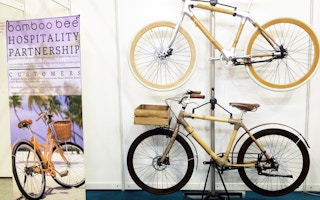Singapore’s annual green building week typically gathers industry professionals for rather technical discussions on the future of buildings. This year, however, the spotlight has moved to consumers and how they, too, can play a part in greener living.
Launched on Friday, the inaugural Green Living Exhibition is the first lifestyle event in the city-state that seeks to educate the public on sustainability issues and cater for eco-friendly consumers.
The exhibition, held at the Marina Bay Sands Expo and Convention Centre (Hall D, Basement 2), is open to the public from 4 to 6 September.
It is organised by Reed Exhibitions and supported by the Building and Construction Authority (BCA), Design Business Chamber Singapore, and Singapore Green Building Council.
The show features over 100 brands displaying products for every aspect of daily life, from construction materials and home fixtures, to furniture, transport, food, electronic devices, clothes, and personal care.
Here are Eco-Business’s top five picks of the exhibition’s offerings.
1. Grow your own greens
Given Singapore’s heavy reliance on food imports, consumers may not always know where their food comes from, or its production methods. While many may prefer their food to be free of genetically modified organisms (GMOs) or harmful pesticides, the long and global supply chain offers them little control over how their food is produced.
These concerns led local entrepreneur Chuah Khai Lin to start MicroGreens, a local urban gardening outfit that provides consumers with the tools to grow leafy greens at home, or even at their desks at work.
Microgreens - or the baby shoots of salad vegetables - are “perfect for busy urbanites in Singapore who like things fast”, Chuah says. Once planted, the seedlings of greens such as arugula, daikon radish, and broccoli take only about a week to grow, she adds.

Microgreens on display - they grow much faster than adult plants but are more nutritious. Image: Eco-Business
Microgreens are between four and six times more nutritious because the seeds provided come packed with nutrients to boost their early growth, says Chuah.
A pack of microgreen seeds retails for about S$5, and lasts for one harvest. A full starter kit consisting of organic seeds, organic compost, and a self-watering pot will also be on sale at the exhibition for $20.
2. From boats to beds
With deforestation accelerating across the world, wood furniture lovers might wonder if the products they buy inevitably contribute to this trend.
To address these concerns Indonesian furniture brand Mountain Teak has made it a point to get most of its raw materials from unique sources: old houses, bridges, and even boats.

Mountain Teak dining tables and shelves made with wood reclaimed from old boats, bridges, and houses. Image: Eco-Business
Randy Abila, sales manager, Mountain Teak, says that about 80 per cent of all wood used by the company is made from such recycled wood, and is certified sustainable by the Forest Stewardship Council, a global certification body for responsibly managed forest products.
The remainder comes from well managed teak plantations in Java, says Abila. Mountain Teak’s furniture also eschews conventional varnishes, which often have a high concentration of harmful volatile organic compounds, in favour of non-toxic, water based alternatives.
3. Getting close to nature
Kenny Eng, director of local nature-based events company GardenAsia, believes that “everyone wants to, and can play a role in adopting an eco-friendly lifestyle”. But to make this happen, connecting with nature “must be no different from everyday life” in terms convenience or enjoyment.
To create fun opportunities for children and families to participate in and learn about green living, the company is organising several workshops at the exhibition.
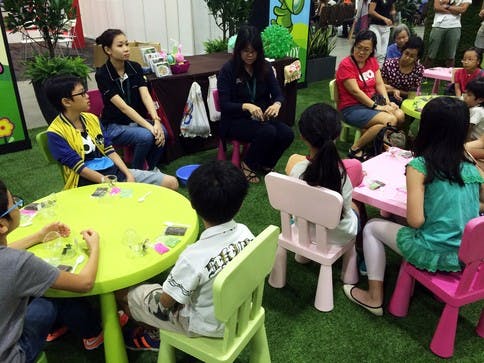
Children attend a workshop on terrarium making at Gardenasia’s booth. Image: Eco-Business
Kids can learn to upcycle old t-shirts and plastic bags into decorative flowers and bags, as well as create their own terrarium at GardenAsia’s exhibition booth.
Meanwhile, parents can wander around the ‘Mumpreneurs’ section of the booth, where entrepreneurial mothers, in a bid to balance motherhood with business, have set up stalls which sell eco-friendly clothes, baby products, and toys.

The Mumpreneurs corner at GardenAsia’s booth, which features women selling handmade goods, or sustainable items sourced from elsewhere. Image: Eco-Business
4. Bamboo-inspired cycling
Urban cycling has a small but devoted following in Singapore, and one company that takes this low-carbon means of transport to a new level of sustainability is local bicycle company Bamboobee.
The company makes sturdy, lightweight bicycle frames out of bamboo, which is gaining popularity worldwide as a strong, low-carbon building material.
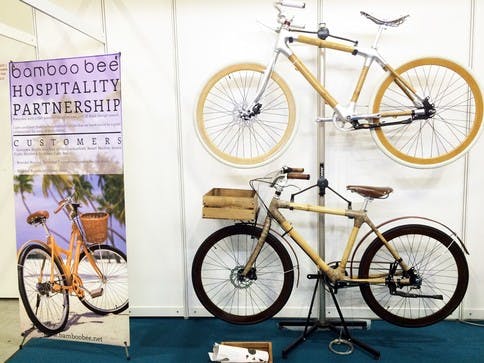
The Bamboobee display at the Green Living 2015 exhibition. Image: Eco-Business
Cycling geeks can pick and choose components for their ideal bicycle frame and assemble it themselves, gaining a sense of satisfaction at having built their own bike. Others may simply opt for the ready-made option, and start their sustainable transport journey in style.
5. Green know-how, now
The Green Living Exhibition also offers a wide range of educational workshops, seminars, and interactive displays which help consumers keep up with the latest green trends.
Visitors can check out the Singapore Sustainability Story exhibit, which presents all the initiatives and policies that the island nation has implemented over the years to balance people’s needs, profits, and environmental protection.
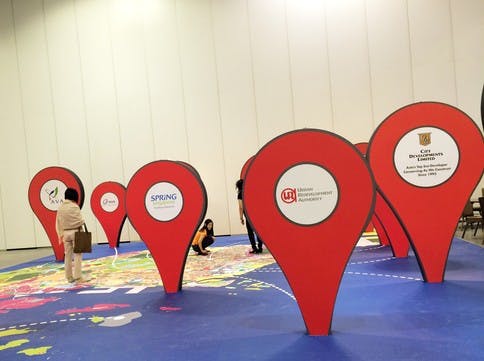
The Singapore Green Story takes visitors through the various policies and initiatives which have helped Singapore achieve the triple bottom line: People, planet, and profit. Image: Eco-Business
Local hardware store Homefix-XPC will also be running a series of do-it-yourself workshops on home improvement projects such as making their own lamps, and up-cycling old glassware into decorative terrariums.
The Building and Construction Authority has also set up an interactive ‘green office’ filled with tips on how making minor behavioural changes can make a big difference to energy and resource consumption in the workplace, and employee health and well-being.
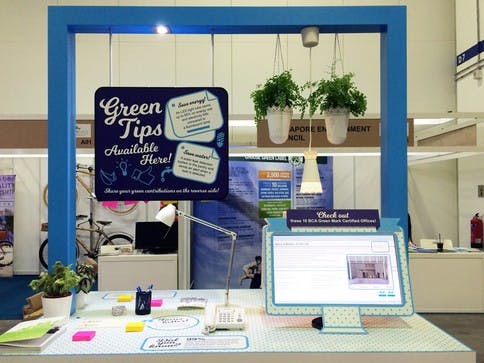
BCA’s Green Office Pop Up display with tips on energy efficiency, reducing resource use, and workplace health and well-being. Image: Eco-Business
John Keung, chief executive officer, BCA, says that this display is an opportunity for visitors “to catch a glimpse of the future of office spaces”.
“I hope the Green Living 2015 exhibition provides green inspirations to all visitors.”
Eco-Business is producing a special e-newsletter featuring stories on the proceedings at IGBC 2015, kindly supported by City Developments Ltd and the Building and Construction Authority. Sign up to receive the newsletter here.

